Serengeti National Park Travel Guide
Courtesy of Matt Champlin | Getty Images


Best Times To Visit Serengeti National Park
The best times to visit Serengeti National Park are from January to February or from June through September, although you should plan your trip around the movement of The Great Migration . For example, winter is the best time to see the herd in Southern Serengeti, while the Western Corridor and Northern Serengeti are the best places to spend the summer and autumn months. Most safari operators will have a good idea of where the animals are headed and when, and most will adjust their itineraries based on the herd's movement. Temperatures remain relatively constant with daytime highs resting in the 80s. You'll find cooler weather in the Ngorongoro Conservation Area due to its higher elevation. April and May see the most rainfall, and many lodges and camps close for this slower season.
Weather in Serengeti National Park
Data sourced from the National Climatic Data Center
Find Flight and Hotel Deals
Navigate forward to interact with the calendar and select a date. Press the question mark key to get the keyboard shortcuts for changing dates.
Navigate backward to interact with the calendar and select a date. Press the question mark key to get the keyboard shortcuts for changing dates.
Explore More of Serengeti National Park

Things To Do

Best Hotels

You might also like

Yellowstone National Park
# 1 in Top 19 Cheap Family Vacations

Grand Canyon National Park
# 1 in Best Day Trips from Phoenix

# 2 in Best Weekend Getaways
If you make a purchase from our site, we may earn a commission. This does not affect the quality or independence of our editorial content.
Recommended
The 50 Best Hotels in the USA 2024
Christina Maggitas February 6, 2024

The 32 Most Famous Landmarks in the World
Gwen Pratesi|Timothy J. Forster February 1, 2024

9 Top All-Inclusive Resorts in Florida for 2024
Gwen Pratesi|Amanda Norcross January 5, 2024

24 Top All-Inclusive Resorts in the U.S. for 2024
Erin Evans January 4, 2024

26 Top Adults-Only All-Inclusive Resorts for 2024
Zach Watson December 28, 2023

Solo Vacations: The 36 Best Places to Travel Alone in 2024
Lyn Mettler|Erin Vasta December 22, 2023

26 Cheap Beach Vacations for Travelers on a Budget
Kyle McCarthy|Sharael Kolberg December 4, 2023

The 50 Most Beautiful White Sand Beaches in the World
Holly Johnson December 1, 2023

The 26 Best Zoos in the U.S.
Rachael Hood November 16, 2023

44 Cheap Tropical Vacations That Feel Expensive
Holly Johnson|Alissa Grisler November 10, 2023


- Northern Circuit
- Western Breach
- Acclimatisation
- Packing List
- Climbing Cost
- Coronavirus
- Visa’s, Vaccinations, Malaria
- Kilimanjaro Blog
- Climb for Charity
- Get A Trek Quote
Serengeti Safari – The Ultimate Planning Guide
Serengeti is an African wilderness that stretches as far as the eye can see. Popular for its wildlife and the Great Wildebeest Migration , a Serengeti safari has a lot on offer.
I've been fortunate enough to visit the Serengeti twice.
In this article I share all my top tips on going on a safari in the Serengeti.
Specifically, you'll find out when is the best time to go, where are the most luxurious and budget-friendly accommodation options, and what types of safaris are on offer.
Let's get started.
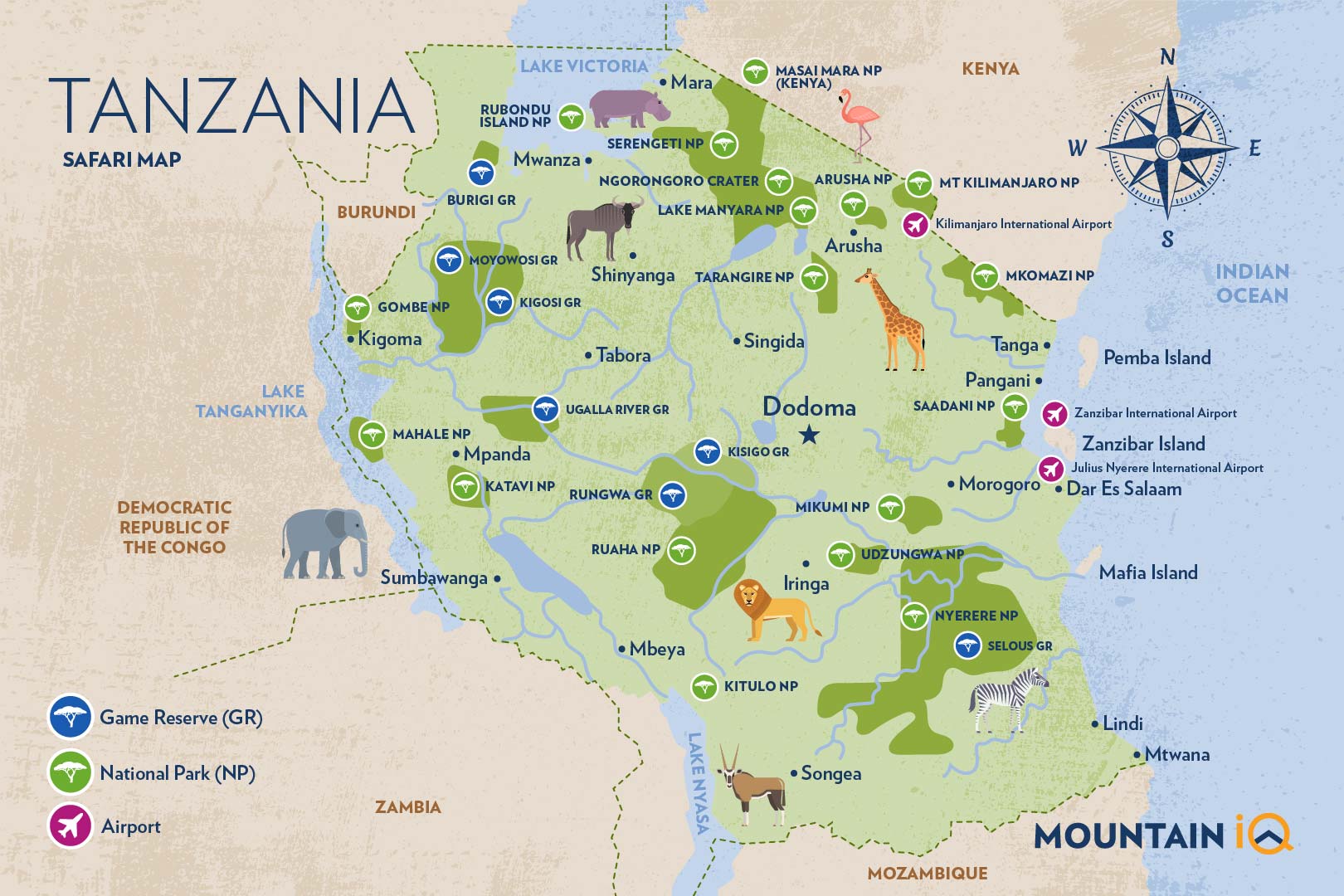
The Serengeti National Park is situated in Northern Tanzania and borders with Kenya.
Serengeti Safari FAQs
Before we jump into the most frequently asked questions, it's worth orientating yourself using the Tanzania Safari Map above. As you'll see the Serengeti is a massive park, measuring 14,763 square kilometres. It's part of Tanzania's famous Northern Circuit, and is usually accessed from Arusha , a town south-east of the park.
In a rush? Here are 5 Serengeti safari tours I recommend:
- Group Camping Safari that includes Tarangire and Ngorongoro (4 days)
- Budget Serengeti Safari (5 days)
- Scenic Northern Tanzania Safari (7 days)
- Serengeti Trail that includes Ngorongoro (8 days)
- Best of Kenya and Tanzania (incl. 6 national parks) (12 days)
See more Serengeti safari deals .
What is the best month to visit the Serengeti?
The peak season from July to October are the best months to go on a safari to the Serengeti as the weather is dry, the wildlife is in abundance and vegetation relatively sparse, which makes viewing easier.
Below is a month-by-month guide to timing your Serengeti safari based on what you want to see.
January-March: Calving Season
Large herds of wildebeest and zebra are gathered in the southern Serengeti and Ngorongoro Conservation Area. January-February also offers a brief dry spell between the rainy seasons.
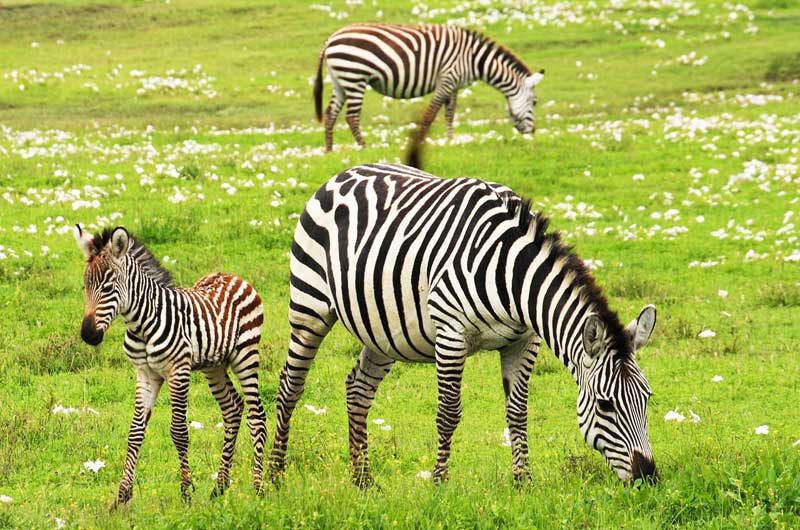
March-May: Out of Season
This is the rainy season so not all of the lodges are open and some roads are inaccessible. Selous Game Reserve and Ruaha National Park are effectively closed during this time, however, the Seronera region has good sightings all year round. Benefits to travelling out-of-season are that there are fewer tourists and safaris and accommodation cost less. Dunia Camp’s rates in April and May are half that of peak season.
May-July: Western Corridor and Seronera
Some wildebeest herds are in the lesser-visited Western Corridor or Grumeti section of the park where visitors may see smaller river crossings. Mobile Camps are set up in central Serengeti which is known for sightings of the big cats.
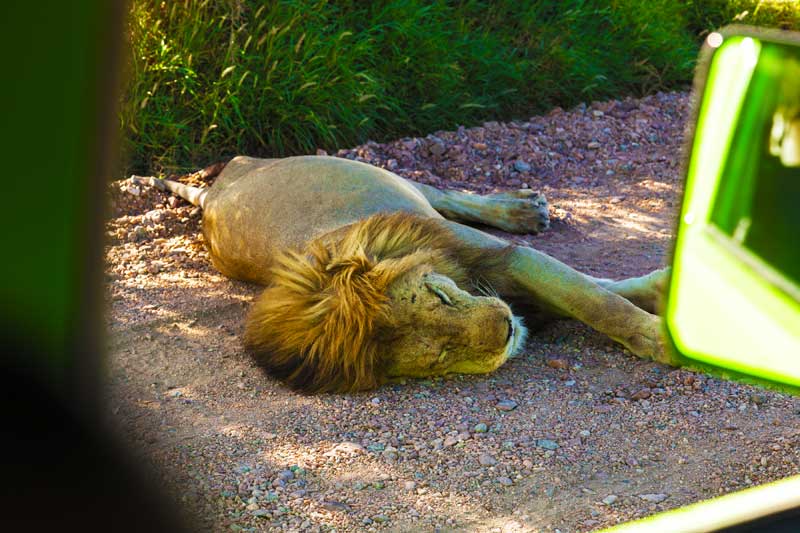
July-October: Dry or Peak Season
The sparse vegetation and gatherings of animals around the water make this the best time for wildlife viewing. This is also the best time to see river crossings at the Mara River in northern Serengeti. Expect more people and vehicles around sightings.
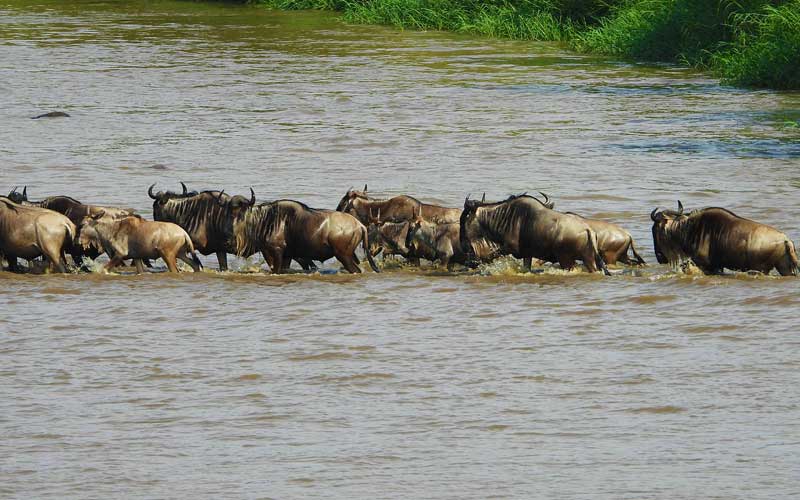
November-December: The Short Rainy Season
For bird lovers, November to April is the best time of year as many species are in breeding plumage and European and African migrant birds are around.
Wet weather also means fewer people and lower prices. Depending on the year, rains could come early or late, so if you are well prepared the risk may be worth it.
How much does a safari in the Serengeti cost?
The average Serengeti safari tour will cost around $1,000 per person for 3-4 days or $1,300 for 5-6 days.
However, the cost depends on how long you're planning on staying and other critical factors like the safari type (private or group tours), transportation (flights), meals, and accommodation (camping or lodges).
Luxury safaris are generally longer with more time in each area and a cost upwards of $10,000 per person. Whereas budget Tanzania safaris can cost as little as $150 per day.
Learn more about Tanzania safari costs and the best safari tour operators in Tanzania . You can also check out which Tanzania safari packages suit you best and how to prepare for your next great adventure.
Additional experiences like hot air ballooning in the Serengeti (from $500 per person) will make your stay extra special. It is worth budgeting for optional extras.
Book a Serengeti Balloon Safari
Get a quote from our recommended local operator
Please Note: Many lodges and camps offer specials for multi-night stays. Shop around before you book.
How long should I spend in the Serengeti?
There is so much to see in the Serengeti so ideally, you’d spend at least a week, but you could conceivably spend two weeks.
If possible, include other areas like the Ngorongoro Crater , Lake Manyara and Tarangire National Park .
Most Serengeti safari tours start at Arusha and stop overnight in popular spots, including some combination of the national parks.
If possible, book to stay longer in more remote areas. This way you avoid rushing between tourist attractions and get to experience a more authentic safari. A longer stay gives you time to explore remote areas and enjoy special experiences.
Bookings should be made as far in advance as possible because the best accommodation and tours fill up quickly, especially over peak season.
Plan your Safari experience
Get a quote from our recommended local safari operator
Which is the best Serengeti safari option?
There are literally 100s of Serengeti safari tour operators, each offering loads of different types of tours.
Here are some of my favourite safari tours:
- Group Camping Safari that includes Tarangire and Ngorongoro (4 days)
- Budget Serengeti Safari (5 days)
- Scenic Northern Tanzania Safari (7 days)
- Serengeti Trail that includes Ngorongoro (8 days)
- Best of Kenya and Tanzania (incl. 6 national parks) (12 days)
See more Serengeti safari deals .
Night safaris are not offered in the Serengeti National park borders but are available in areas just outside of the park, including Singita’s Sasakwa, Faru Faru and Sabora. Here you might encounter such nocturnal creatures as bat-eared foxes, aardvark, aardwolf, porcupine, bush babies and African civets.
What is the difference between the Serengeti, Ngorongoro and Masai Mara?
The differences between Serengeti, Ngorongoro and Masai Mara come down to four important factors: geography, size, varieties in wildlife and tourist populations.
While Serengeti and Ngorongoro are 200km (about 124 mi.) apart in Northern Tanzania, Masai Mara is on the south-west border of Kenya and 192km (about 119 mi.) from Serengeti.
Of the three, Serengeti National Park is the largest conservation area, measuring 14, 763 km² (about 5700 sq mi), whereas the Masai Mara National Park is 1,510 km² (roughly 583 sq mi) and the Ngorongoro Crater is 264 km² (roughly 102 sq mi). In layman terms, Serengeti is about 20 times the size of Masai Mara while Masai Mara is 7 times the size of Ngorongoro.
Other differences include what wildlife species can be found in each region. Serengeti boasts 35 species of wildlife (with numerous wildebeest, lions, birds and zebras) and the setting of 80% of the wildebeest migration route. In Serengeti, there are always migrating herds. In comparison, Ngorongoro is home to over 300 wildlife species (like flamingos, hyenas, jackals and cheetahs) while Masai Masa boasts 90 wildlife species (as well as giraffes, hippos, cheetahs and zebras). Also, unlike Serengeti and Masai Mara, you will only be able to see certain animals like giraffes, impalas and crocodiles in the Ngorongoro Conservation Area, but not in the crater itself.
With that said, Serengeti, Ngorongoro and Masai Mara do share some commonalities, like the popular wildebeest migration and notable sightings of the Big 5 .
When it comes to choosing tourist destinations, Tanzania is generally less crowded than Kenya which makes for a more exclusive safari. Unless seeing Kenya is your goal, Tanzania is generally the better safari option.
It might just be that a combined Kenya and Tanzania safari package is more practical so you can get the best of both worlds.
What wildlife will I see in the Serengeti?
The Serengeti has over 1.5 million wildebeest and 250,000 zebra. It also has over 35 species of plain animals, and the largest lion population (roughly 3000 lion) in Africa.
Of all the Serengeti Animals , the Big 5 are the most sought after and you'll be pleased to hear that the Serengeti has all of them.
There are also more than 540 species of birds recorded in the Serengeti. Some of them cannot be found anywhere else in the world! Many companies offer specialist birdwatching safaris.
In terms of the Big 5, here are some top tips to see them:
- Elephants avoid the noisy herds of wildebeest and zebra but occur in large numbers across the park along with giraffes, eland and other antelope species.
- Buffalos prefer to hang out close to water and rivers which are also where you can spot crocodiles and hippos.
- Big cats and other predators like hyenas follow the herds. Leopards and lions are especially common in the Seronera region.
- The Black rhino is present in the park but in low numbers and difficult to find, consider yourself especially lucky if you get to see one!
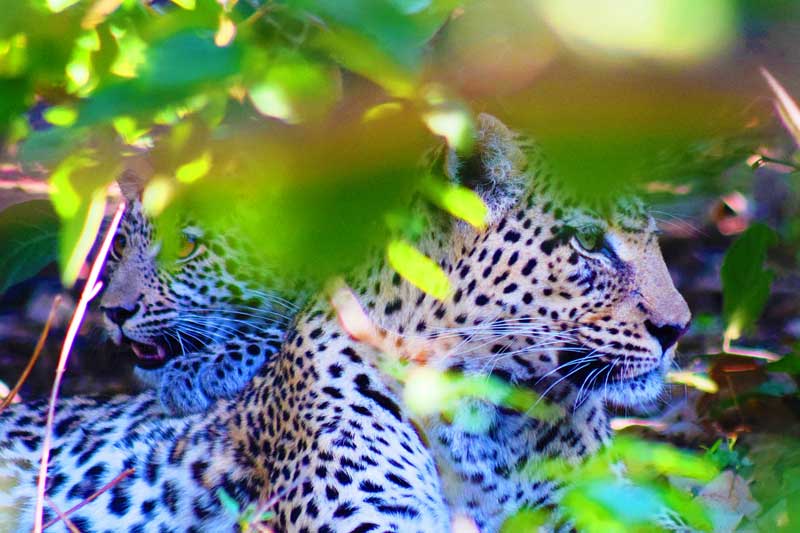
When is the best time to see the wildebeest migration in the Serengeti?
The best time to see the great migration in the Serengeti depends on the month you plan to go on safari. The map below gives you a rough indication where the migrating herds are in the park by month.
Find out more about the great wildebeest migration .
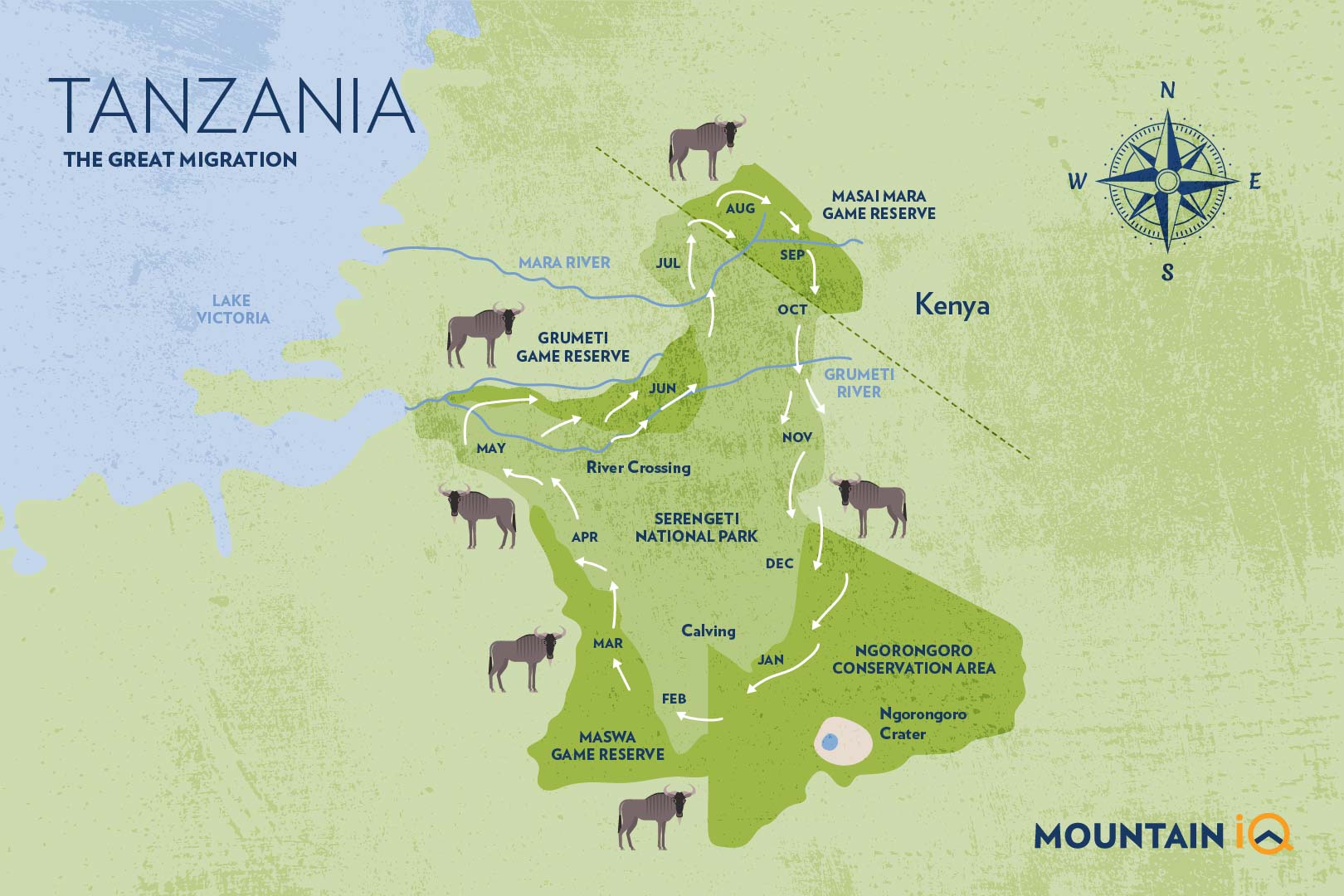
What accommodation options are there on a safari in the Serengeti?
There are three main accommodation options on a Serengeti safari: camping, mobile camps and lodges.
A great option for adventurous souls. Camping equipment can be rented or you can book camping trips through some safari operators. There are two main campsites in the Serengeti National Park: Seronera and Lobo.
Campsites have very basic facilities of public bathrooms and a communal area for cooking. Camping is the most affordable option, but it is not for everyone.
See camping options .
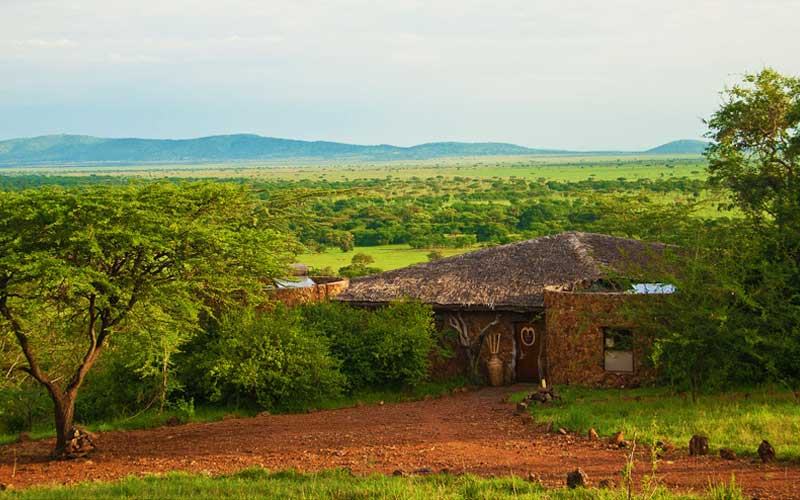
Mobile Camps
This is the ultimate combination of privacy and luxury (and your own bathroom!) with the feeling of being up close to nature. Sleep in a real bed and still hear the leaves rustle and jackal cry in the distance.
Mobile tented camps like Alex Walker’s Serian, Olakira, Nomad’s Serengeti and Serengeti Under Canvas move around as they follow the herds from calving grounds up central and western Serengeti north to the Mara River.
See mobile camp accommodation options .
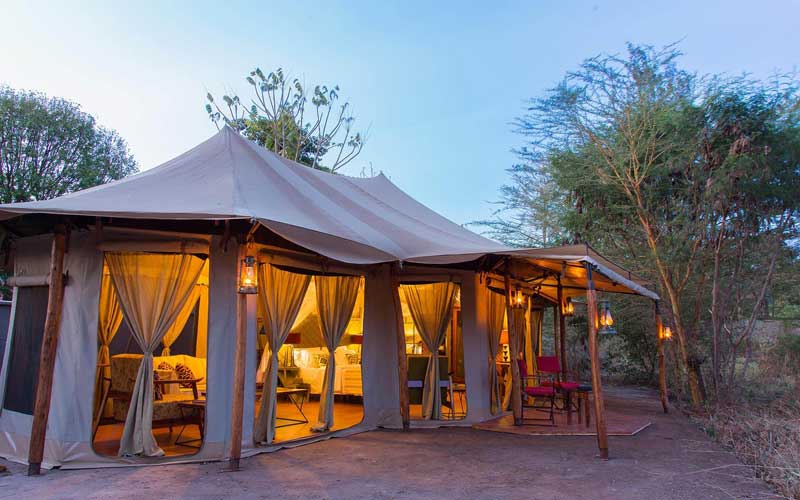
Lodges and Permanent Camps
There are permanent camps and lodges in the Serengeti National Park that have more facilities and creature comforts. This may be a good choice for families with young children as many have swimming pools and special children’s programmes to entertain the little ones between drives.
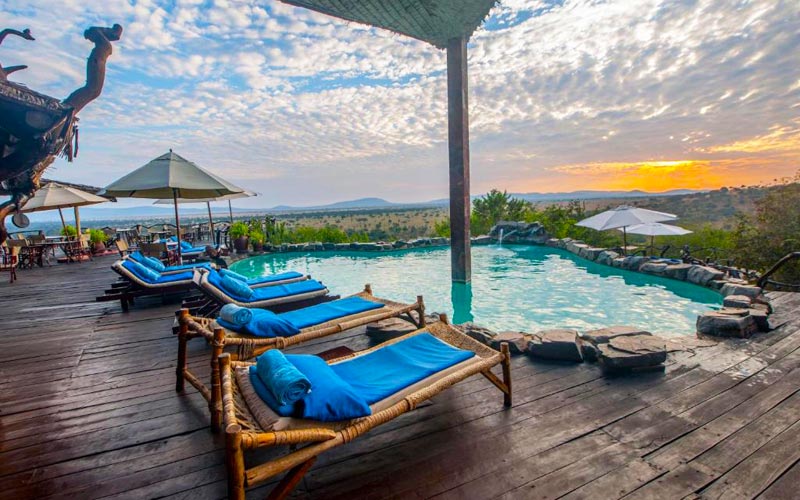
Mbalageti Safari Camp
Most permanent accommodation sites, including Sayari, Nomad Lamai and Lobo Lodge (which is more budget-friendly) are up north closer to the Mara River. Kusini Camp and Ndutu Lodge are in the south, and Singita has three camps on the Western corridor.
See lodge options .
Please Note: For reliable WiFi, lodges and permanent camps are your best bet.
Where to stay? Here are 5 of my favourite accommodation options in the Serengeti:
- Africa Safari Serengeti Ikoma
- Serengeti Serena Safari Lodge
- Ole Serai Luxury Camp
- Asanja Africa
- Melia Serengeti Lodge
See more Serengeti accommodation options .
How do I get to the Serengeti?
Most Serengeti safaris start in the town of Arusha. From here it takes around 8 hours to drive to the Serengeti National Park. It could be better to split the long drive by spending a night in one of the visit-worthy Ngorongoro Crater, Lake Manyara or Tarangire national parks.
If you're travelling in July-September time when the Wildebeest Migration is in the northern part of the Serengeti, it can be better to travel from the Kenyan side.
Finally, there is the option to charter a flight from Arusha .
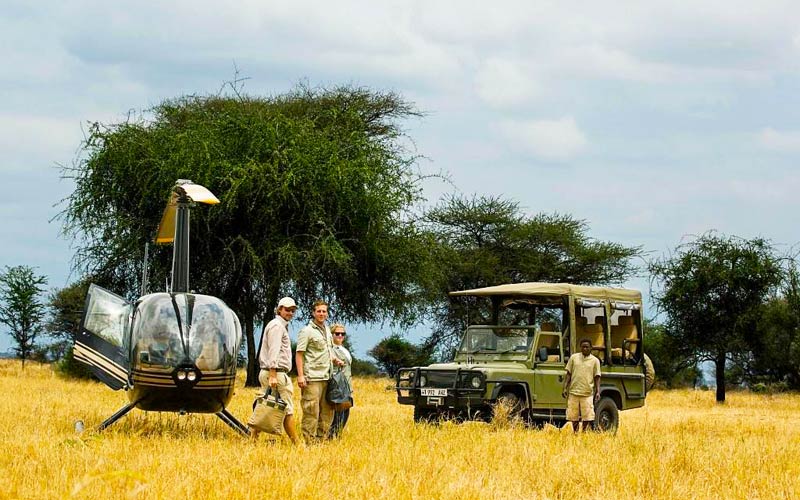
Here are details of shuttle flights flying from Arusha into the Serengeti.
*Costs are subject to change. These are just guide prices.
Please Note: small planes have strict baggage restrictions of 15kg per person, including any hand luggage and duffel bags. The costs are per person and are subject to change.
How safe is a Serengeti Safari?
Going on a safari in the Serengeti is a safe and fun experience. Always listen to your ranger’s instructions and note basic guidelines:
- Never go out walking outside of camp or alone after dark
- Keep your limbs and head inside the vehicle
- Do not make loud noises on a safari
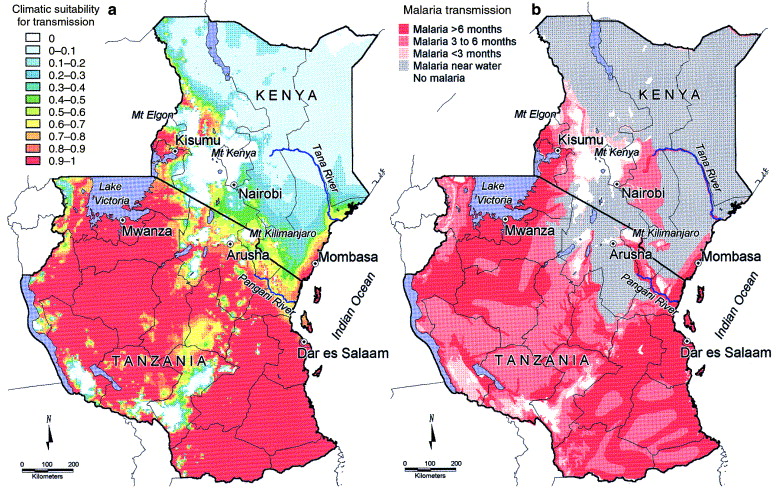
Please note : Malaria is a risk in Tanzania, so consult your doctor about medication options before setting off. Make sure to pack a first aid kit with necessities including band-aids, headache tablets and diarrhea medication.
What food will I get on a Serengeti Safari?
To make the most of game-viewing, you will be spending most of the day out in the vehicle. This means that meals will often be packed picnic-style – breakfasts, lunches and snacks along the lines of sandwiches or wraps, fresh fruit, cheese, cold meats, muffins and pastries.
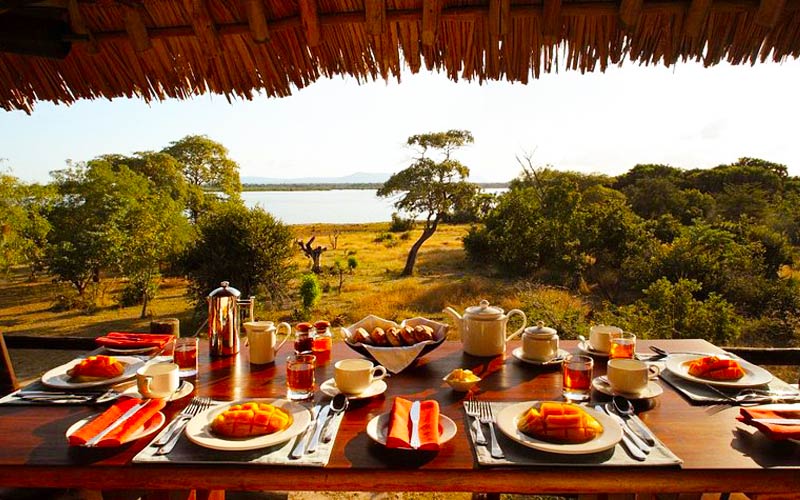
It is important to let your tour operator or camp chef know about any dietary requirements in advance. They will be happy to cater accordingly.
Please Note : It is illegal to feed the animals, take leftover food back with you to the camp.
Alison Macallister
With a degree in Nature Conservation and experience working with wildlife including the Big 5, Alison works as a guide for a 5-star reserve. She enjoys sharing her passion for all things nature-related. She enjoys hiking, horseriding, 4x4 driving and kayaking.
Leave a Reply
Your email address will not be published. Required fields are marked
Name * * * * *
Email * * * * *
Get a quote from our recommended local Kilimanjaro operator
- You are here:
- Countries & Parks
- Tanzania Parks
Serengeti National Park
- Weather & Climate

- Best Time To Visit
- Getting There
- Malaria & Safety
Weather & Climate – Serengeti NP

Philip is a renowned Africa expert and author of many Bradt guidebooks to African destinations, including the guide to Tanzania.
Philip is a renowned Africa expert and author of the Bradt guidebook to Tanzania.
Philip is the author of the Bradt guidebook to Tanzania.

Climate Chart Serengeti National Park – 1,140-2,099m / 3,740-6,886ft

The climate in Serengeti National Park is usually moderate and pleasant. It never gets very hot, but it is consistently cool to cold at night and in the early mornings. Don't forget to take warm clothing. Serengeti's Dry season is from June to October. The Wet season consists of two rainy periods: the short rains (November to December) and the long rains (March to May), with a dry spell in between. During the Wet season, it rarely rains all day, but afternoon thundershowers can be expected.
Afternoon temperatures are usually around 26°C/79°F. The sky is clear most days. It gets cold at night with minimum temperatures around 14°C/57°F.
- June, July, August & September – Occasional cold fronts are possible, with temperatures close to freezing. It's usually chilly early in the morning.
- October – The short rains might start at the end of October if they are early.
Wet Season – November to May
- November & December – 'Short rains' – An unpredictable period of about a month of rains occurs sometime between November and December. The rains will be unlikely to interfere with your safari.
- January & February – There is usually a dry spell between the short and long rains. The exact timing is unpredictable.
- March, April & May – 'Long rains' – These are the wettest months. It tends to rain most days, although seldom for the whole day. It is often cloudy.
Want To Visit Serengeti NP?
3,020 Serengeti Safaris
- Serengeti Group Safaris
- Serengeti Fly-in Safaris
- 5-Day Serengeti Safaris
- Tour Operators for Serengeti
Serengeti NP Photos

Safari Tours to Serengeti NP

7-Day Tanzania Holiday Experience & Materuni Waterfalls
$1,320 pp (USD)
Tanzania: Shared tour (max 6 people per vehicle) Camping & Hotel
You Visit: Arusha (Start) , Tarangire NP, Serengeti NP, Ngorongoro Crater, Lake Manyara NP, Materuni (Highlight) , Arusha (End)
Go Serengeti African Tours
5.0 /5 – 121 Reviews

8-Day Great Migration Safari
$3,135 pp (USD)
Tanzania: Private tour Lodge & Tented Camp
You Visit: Arusha (Start) , Tarangire NP, Central Serengeti, Northern Serengeti NP, Serengeti NP, Ngorongoro Crater, Foothills of Mt Kilimanjaro, Arusha (End)
Safari Soles
5.0 /5 – 245 Reviews

6-Day Northern Parks Comfort
$2,593 pp (USD)
Tanzania: Private tour Tented Camp
You Visit: Arusha (Start) , Tarangire NP, Serengeti NP, Ngorongoro Crater, Lake Manyara NP, Arusha (End)
Shemeji Safari Tanzania
4.8 /5 – 282 Reviews

- --> Reviews --> About Us --> Blog --> Contact --> Safaris --> Itineraries --> Family Bush & Beach Safari --> Classic Tanzania --> Short & Sweet --> Closer to Nature --> Big 5 Explorer --> Ultimate South --> Southern Highlights --> Western Highlights --> Cultural, Wildlife, Hiking --> Tanzania National Parks --> Wildebeest Migration --> Honeymooners --> Cultural Safaris --> Accommodations --> Climbing & Trekking --> Kilimanjaro --> Mount Meru --> Ngorongoro Highlands --> Responsible Tourism --> Our Commitment --> Volunteering --> Charity --> Kilimanjaro Climbing --> Lemosho Route --> Machame Route --> Rongai Route --> Northern Circuit Route --> Route Comparison --> Quest From The West Lemosho 8 Days --> Above The African Plains Rongai 7 Days --> Without The Whiskey Machmae 7 Days --> Orbit Kilimanjaro Northern Circuit 9 Days --> Twin Peaks Meru And Kili 12 Days --> Tailor Made Private Treks --> Join Kilimanjaro Group --> Safari & Beach Extensions --> Why African Scenic --> Safety & Success --> Training & Experience --> Ethical Climbs --> Tried & Tested --> Kilimanjaro Climbing Guide --> Pre-Climb Preparation --> When To Climb --> Equipment & Packing --> Training For Kilimanjaro --> Travel Insurance --> Kilimanjaro FAQ --> Inspiring Stories --> Booking Information --> On The Mountain --> Camp Life --> Food & Nutrition --> Acclimatization & Altitude --> Upgrade your Climb --> Tailor-Made Tanzania Experiences --> Tailor-Made Kilimanjaro Experiences --> --> Enquire Online --> --> --> Menu --> --> National Parks --> Quest From The West --> Above The African Plains --> Without The Whiskey --> Orbit Kilimanjaro --> Twin Peaks --> Mount Meru Climbing -->